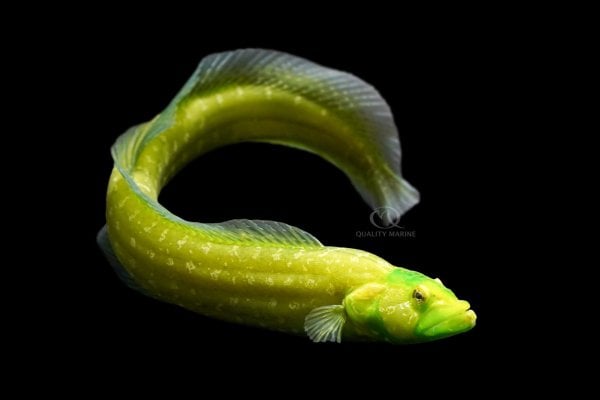Let's all take a vote on what fish is the most commonly misidentified and/or misnamed fish in aquarium keeping. While you mull over your answer, the correct one is Congrogadus subducens. Looks like an Eel, acts like a Blenny, and it gets called either and sometimes both and at least one common name calls it a Perch (Green Eel Perch). Spoiler alert, it's a Pseudochromis, the one thing it is pretty much never called. Depending on where you live you might call this fish any number of names like Carpet Conger, Mud Blenny, Daggerfish, Eared Eel, Launce, Mud Blenny, Ocellated Eel Blenny and the most popular two: Carpet Eel Blenny and Green Wolf Eel, though a staff favorite around here is Lurking Machete, how cool is that? Danny Trejo needs one of these.
Beyond its plethora of common misnomers, this is a very cool fish. They do look very eel like, and if you haven't seen one before, check these pictures out and maybe hit YouTube to watch a couple videos about them, they are one of the coolest and hardiest oddball fish around. In regard to other Pseudochromis or Blennies, The Green Wolf Eel/Blenny gets huge; there is no IGFA record for a hook and line capture, but the largest specimen ever collected was 18 inches tip to tail (much bigger than you are ever likely to achieve in your home aquarium). However, when compared to most commonly available Eels for the home aquarium, it is positively petite! They are usually some shades of green with brown camouflage, or vice versa, though nearly white ones have been recorded, and they are capable of a moderate level of color change to better hide in their environment.
Food wise, the Green Wolf Eel/Blenny has an appetite that lives up the expectations of the name. In the wild, this fish would be an ambush hunter, eating pretty much anything that moves as long as it fits in its mouth. This makes it pretty easy to feed in the home aquarium and they'll usually house down most thawed meaty food. When they are smaller, they'll do well on foods like Gamma Krill (Superba and Pacifica); Gamma also offers Whole Mussel, Whole Cockle and Whole Fish, and these are all perfect for Congrogadus subducens well into adulthood but may have to be cut down for younger individuals. Variety is important in their diet, and timing is infrequent. Until they are four or five inches long, you should feed them once a day, but after they hit six inches or so, these feedings should decrease. Monitor your fish's behavior and body. If they're getting plus sized and aren't that interested in meals, decrease frequency. If they're looking a bit skinny and their belly is more sunk in than usual, either increase the size of the meal, or the frequency of foods. If your fish aren't that interested in your offerings, try using a feeding stick to give some life to it. It's very rare that you'll need to offer live food, but for those of you with a clean source for live feeders like saltwater guppies, mollies or shrimp, this is always fun to watch! Once these fish associate you with food, they're going to be very excited to see you walk up to the tank! Click here to learn more

Beyond its plethora of common misnomers, this is a very cool fish. They do look very eel like, and if you haven't seen one before, check these pictures out and maybe hit YouTube to watch a couple videos about them, they are one of the coolest and hardiest oddball fish around. In regard to other Pseudochromis or Blennies, The Green Wolf Eel/Blenny gets huge; there is no IGFA record for a hook and line capture, but the largest specimen ever collected was 18 inches tip to tail (much bigger than you are ever likely to achieve in your home aquarium). However, when compared to most commonly available Eels for the home aquarium, it is positively petite! They are usually some shades of green with brown camouflage, or vice versa, though nearly white ones have been recorded, and they are capable of a moderate level of color change to better hide in their environment.
Food wise, the Green Wolf Eel/Blenny has an appetite that lives up the expectations of the name. In the wild, this fish would be an ambush hunter, eating pretty much anything that moves as long as it fits in its mouth. This makes it pretty easy to feed in the home aquarium and they'll usually house down most thawed meaty food. When they are smaller, they'll do well on foods like Gamma Krill (Superba and Pacifica); Gamma also offers Whole Mussel, Whole Cockle and Whole Fish, and these are all perfect for Congrogadus subducens well into adulthood but may have to be cut down for younger individuals. Variety is important in their diet, and timing is infrequent. Until they are four or five inches long, you should feed them once a day, but after they hit six inches or so, these feedings should decrease. Monitor your fish's behavior and body. If they're getting plus sized and aren't that interested in meals, decrease frequency. If they're looking a bit skinny and their belly is more sunk in than usual, either increase the size of the meal, or the frequency of foods. If your fish aren't that interested in your offerings, try using a feeding stick to give some life to it. It's very rare that you'll need to offer live food, but for those of you with a clean source for live feeders like saltwater guppies, mollies or shrimp, this is always fun to watch! Once these fish associate you with food, they're going to be very excited to see you walk up to the tank! Click here to learn more












